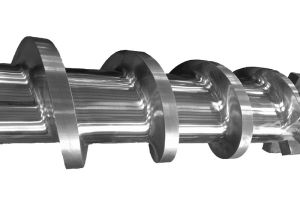
TOOL STEEL SCREWS
Although some manufacturers produce screws made from conventional tool steels, such as D-2 or H-13, most new tool steel screws are made from tool steels produced from a Particle Metallurgy Process (PM). Rather than making the tool steel from poured ingots and rolled, the PM process utilizes atomization and isostatic compression to make the steel. Prealloyed molten steel is atomized into a spray of micro ingots (powder consistency) of uniform size that are poured into a large canister which is sealed under vacuum. The canister is then placed in an autoclave where high heat and isostatic compression is applied. This method allows steels to be made with a much larger percent of alloys without alloy segregation. Tool steels made by the PM process that are used for screws include PM9V, PMM4, and PM S90V.
...more
Screws
Most screws are made from 4140 steel and then flame hardened and chrome plated. They can also be carburized and nitrided, and a hard surface obtained by spraying on a layer of metal. Worn screws can be rebuilt several times, providing that there is not excessive wear.
...more
A 4140 alloy steel screw
A 4140 alloy steel screw can be nitrided satisfactorily, however, a nitriding steel (such as Nitralloy 135M) has aluminum added to give a better response in nitriding hardness, both as to consistency and depth. There are two types of nitriding that are common to screw manufacture: Gas Nitriding and Ion Nitriding. Gas Nitriding is used to create a surface hardness on the screw. The hard layer of steel will vary in depth from .007” to .015” depending upon the length of the nitriding cycle. The hard layer (usually well above 60 Rc) is achieved by heating the steel in an atmosphere of nitrogen (ammonia gas) at temperatures of 950 to 1050 degrees F. The nitrogen atoms are diffused into the surface of the steel, combining with nitride-forming elements, such as chromium, aluminum, molybdenum, vanadium, tungsten and titanium, to produce a very hard surface, particularly for the first .002” to .005” depth. Nitrided screws have a very good wear resistance until the surface hardness is worn away. After the surface is worn .007”, wear accelerates and the screw may quickly be worn to a condition that is beyond repair. Ion Nitriding is similar to Gas Nitriding, using an electrical potential to ionize low pressure nitrogen gas. The ions produced are accelerated to the surface of the steel, heating it to a temperature for diffusion to take place (i.e., the uniting of the atomic nitrogen with the nitride-bearing elements in the steel). Because the temperatures are lower and pressures more controllable, a more uniform surface hardness depth may be achieved. The ionization occurs in a plasma discharge process which creates a glow, hence, this type of nitriding is also referred to as the “plasma method” or “glow discharge” nitriding.
...moreBe first to Rate
Rate This